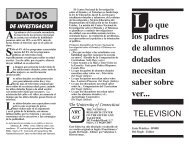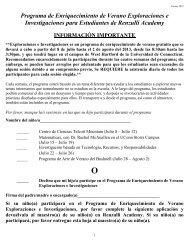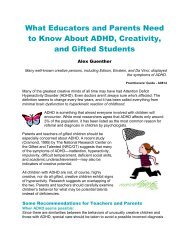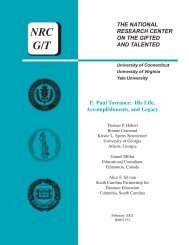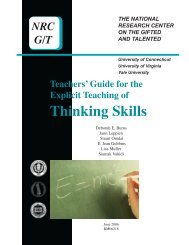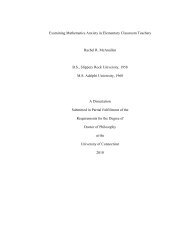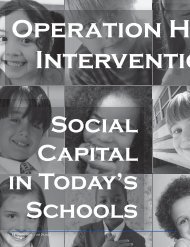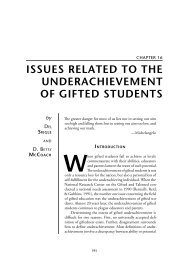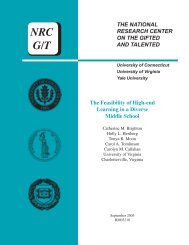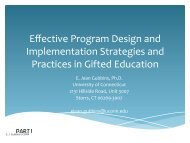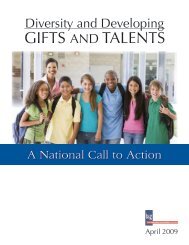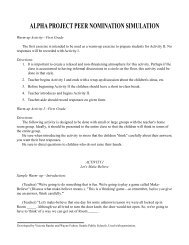Giftedness and High School Dropouts - Neag Center for Gifted ...
Giftedness and High School Dropouts - Neag Center for Gifted ...
Giftedness and High School Dropouts - Neag Center for Gifted ...
Create successful ePaper yourself
Turn your PDF publications into a flip-book with our unique Google optimized e-Paper software.
<strong><strong>Gifted</strong>ness</strong> <strong>and</strong> <strong>High</strong> <strong>School</strong> <strong>Dropouts</strong>:<br />
Personal, Family, <strong>and</strong> <strong>School</strong>-related Factors<br />
Joseph S. Renzulli<br />
Sunghee Park<br />
University of Connecticut<br />
Storrs, Connecticut<br />
EXECUTIVE SUMMARY<br />
Introduction<br />
Research studies report that high school dropout rates still remain at high levels<br />
<strong>and</strong> vary significantly by socioeconomic status <strong>and</strong> racial/ethnic background (Lunenburg,<br />
2000; Naylor, 1989; National <strong>Center</strong> <strong>for</strong> Education Statistics, 2001). Rumberger (1987)<br />
indicated that educators <strong>and</strong> policymakers have given attention to the issue of high school<br />
dropouts because of the large percentage of minority students who leave school be<strong>for</strong>e<br />
graduation. In addition, the per<strong>for</strong>mance of schools is sometimes judged by the dropout<br />
rates of these populations. Naylor (1989) pointed out that a great amount of money<br />
should be spent <strong>for</strong> these dropouts' welfare <strong>and</strong> lost revenue.<br />
While the issue of high school dropouts has received much attention, the dropout<br />
rate of gifted <strong>and</strong> talented students has been studied less often at local <strong>and</strong> national levels<br />
(Robertson, 1991; Sadowski, 1987; Stephenson, 1985). There<strong>for</strong>e, little is known about<br />
these students. Previous studies have reported a wide range of estimates of gifted drop<br />
out rates. These estimates vary with the definitions of "giftedness" <strong>and</strong> "dropouts."<br />
Lajoie <strong>and</strong> Shore (1981) criticized that gifted dropout studies used vague definitions of<br />
gifted, varied in age <strong>and</strong> grade levels <strong>and</strong> needed to follow up on the permanence of those<br />
having dropped out. In fact, many studies about gifted dropouts have focused on<br />
academically high ability students, selected primarily by IQ scores. However, recent<br />
trends in gifted <strong>and</strong> talented education have employed more flexible definitions. Another<br />
issue in the study of gifted dropouts is the difficulty in obtaining nationally representative<br />
longitudinal data about this population (Robertson, 1991).<br />
Nationally representative longitudinal data from the National Education<br />
Longitudinal Study of 1988 (NELS:88) were used in researching this population. The<br />
longitudinal data included a variety of personal, family, <strong>and</strong> school variables related to<br />
high school students' dropout decisions. The purpose of this study was to gain<br />
comprehensive in<strong>for</strong>mation from the NELS:88 data set about gifted dropout students<br />
regarding their reasons <strong>for</strong> leaving school; parents' reactions; use of time; future career<br />
plans; relationships with parents <strong>and</strong> peers; <strong>and</strong> self-concepts. It also compared gifted<br />
dropouts with gifted non-dropouts in terms of personal <strong>and</strong> educational factors related to<br />
decisions to drop out of school.<br />
vii



